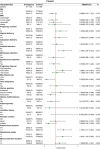High-risk factors for massive haemorrhage in medical abortion patients with missed miscarriage
- PMID: 39245736
- PMCID: PMC11382378
- DOI: 10.1186/s12884-024-06682-x
High-risk factors for massive haemorrhage in medical abortion patients with missed miscarriage
Abstract
Background: Recently, the incidence of missed miscarriage has gradually increased, and medical abortion is a common method to terminate a pregnancy. In the process of medical abortion, massive vaginal bleeding takes place, leading to emergency surgical haemostasis. Emergency surgery may produce infection and organ damage. Our study aimed to investigate the high-risk factors for massive haemorrhage during a medical abortion.
Methods: A total of 1062 missed miscarriage patients who underwent medical abortion participated in this retrospective study. According to the amount of bleeding, the patients were divided into a massive haemorrhage group and a control group. By comparing the general conditions of the two groups, such as fertility history, uterine surgery history, uterine fibroids, etc., the high-risk factors for massive haemorrhage during medical abortion were identified.
Results: Relative to the control group, the massive haemorrhage group exhibited a higher proportion of patients with a previous artificial abortion (51.9% vs. 38.1%, P = 0.001). Additionally, the massive haemorrhage group had a lower percentage of first-time pregnant women (32.1% vs. 40.4%) and a higher proportion of women with shorter pregnancy intervals (44.9% vs. 33.1%, P = 0.03). Furthermore, there were notable differences between the two groups regarding maximum fibroid size, the duration of amenorrhea, and gestational week (P < 0.05).
Conclusion: In this study, we determined that a history of artificial abortion and an amenorrhea duration of > 11 weeks represented high-risk factors for massive vaginal bleeding during medical abortion in missed miscarriage patients.
Keywords: Emergency surgery; Massive haemorrhage; Medical abortion; Missed miscarriage.
© 2024. The Author(s).
Conflict of interest statement
The authors declare no competing interests.
Figures
Similar articles
-
Expectant versus surgical management of first-trimester miscarriage: a randomised controlled study.Arch Gynecol Obstet. 2014 May;289(5):1011-5. doi: 10.1007/s00404-013-3088-1. Epub 2013 Nov 16. Arch Gynecol Obstet. 2014. PMID: 24240972 Clinical Trial.
-
Trends in the incidence, rate and treatment of miscarriage-nationwide register-study in Finland, 1998-2016.Hum Reprod. 2019 Nov 1;34(11):2120-2128. doi: 10.1093/humrep/dez211. Hum Reprod. 2019. PMID: 31747000
-
Medical management of first trimester missed miscarriage: the efficacy and complication rate.J Obstet Gynaecol. 2019 Jul;39(5):647-651. doi: 10.1080/01443615.2018.1535577. Epub 2019 Mar 27. J Obstet Gynaecol. 2019. PMID: 30917727
-
[Misoprostol: off-label use in the first trimester of pregnancy (spontaneous abortion, and voluntary medical termination of pregnancy)].J Gynecol Obstet Biol Reprod (Paris). 2014 Feb;43(2):123-45. doi: 10.1016/j.jgyn.2013.11.007. Epub 2014 Jan 13. J Gynecol Obstet Biol Reprod (Paris). 2014. PMID: 24433988 Review. French.
-
Fertility after contraception or abortion.Fertil Steril. 1990 Oct;54(4):559-73. doi: 10.1016/s0015-0282(16)53808-4. Fertil Steril. 1990. PMID: 2209874 Review.
Cited by
-
Diagnostic value of serum human chorionic gonadotropin and uterine artery Doppler indices in missed abortion.Am J Transl Res. 2025 Jun 15;17(6):4225-4236. doi: 10.62347/HJTF3431. eCollection 2025. Am J Transl Res. 2025. PMID: 40672627 Free PMC article.
References
-
- 2019 exceptional surveillance of ectopic pregnancy. And miscarriage: diagnosis and initial management (NICE guideline NG126) [Internet]. London: National Institute for Health and Care Excellence (NICE); 2019. Nov 15. - PubMed
MeSH terms
Grants and funding
LinkOut - more resources
Full Text Sources
Medical



